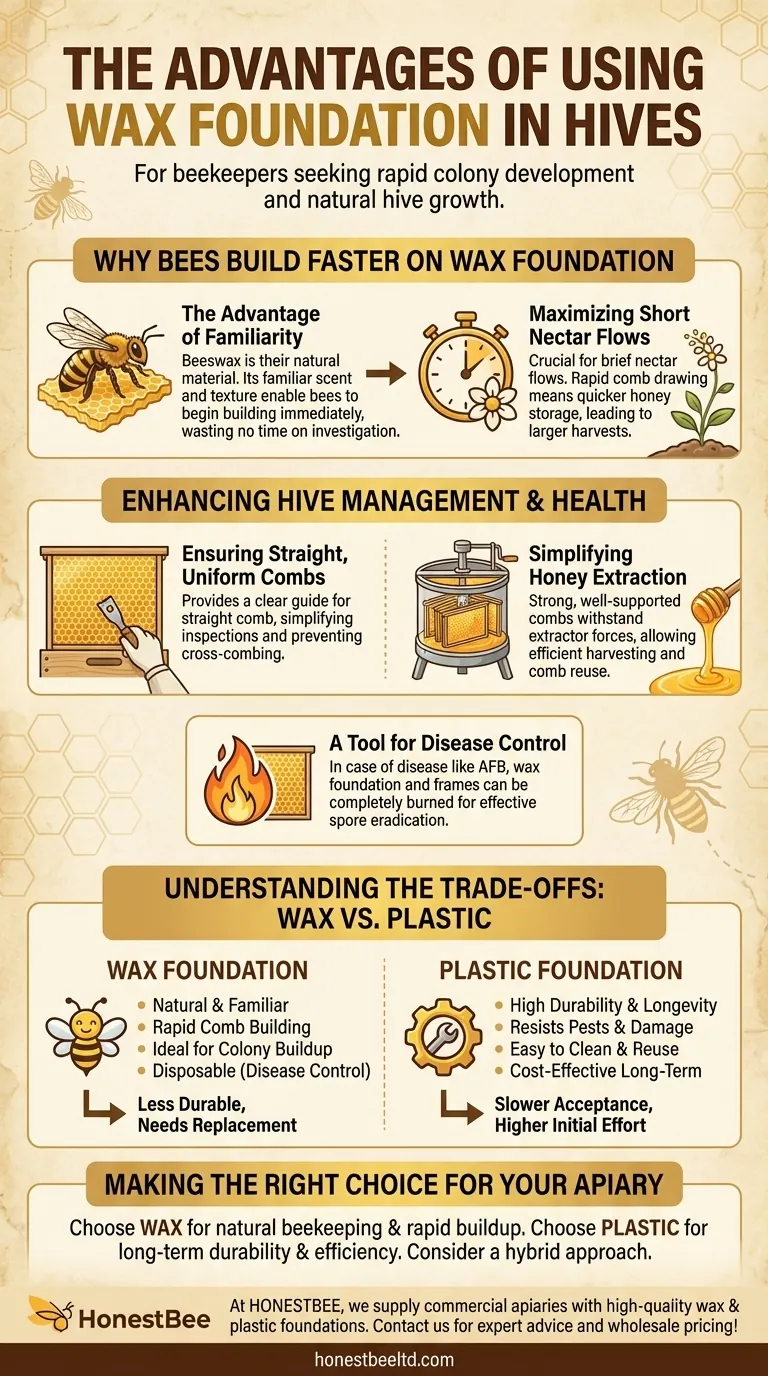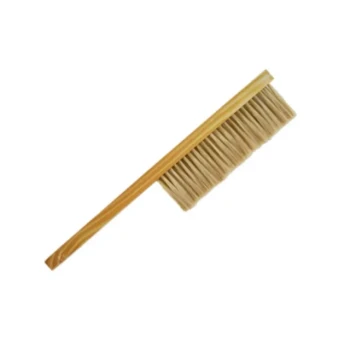For beekeepers seeking rapid colony development, wax foundation is often the superior choice. Its primary advantage lies in its natural composition, which encourages bees to begin building comb more quickly than they do on artificial alternatives, a critical benefit during short nectar flows.
The core decision between foundation types is not about which is universally "better," but which aligns with your specific goals. Wax foundation excels at promoting natural bee behavior and speed, while plastic foundation offers durability and long-term convenience.

Why Bees Build Faster on Wax Foundation
A primary goal in beekeeping is to have bees draw out comb quickly and efficiently. The material of the foundation plays a significant role in how readily they accept this task.
The Advantage of Familiarity
Beeswax foundation is made from the very material bees produce themselves. It emits a familiar scent and has a texture that bees instinctively know how to work with.
This natural acceptance means bees waste less time investigating the surface and get to the work of drawing out the cells much faster.
Maximizing Short Nectar Flows
In regions with a brief but intense nectar flow, speed is essential. A colony that can draw comb quickly can store more honey.
Wax foundation gives the bees a head start, ensuring they can capitalize on available resources without delay. This can directly translate to a larger honey harvest.
Enhancing Hive Management and Health
Beyond speed, using foundation provides structure that simplifies hive management and supports colony health. Wax foundation offers a natural way to achieve these benefits.
Ensuring Straight, Uniform Combs
Any foundation, wax or plastic, provides a guide for bees, encouraging them to build straight combs within the frame.
This uniformity is crucial for hive inspections, as it prevents cross-combing and allows the beekeeper to remove frames easily without damaging the comb or angering the colony.
Simplifying Honey Extraction
Straight, well-supported combs are strong enough to withstand the centrifugal force of a honey extractor.
This allows beekeepers to harvest honey efficiently and return the empty, intact combs to the hive, saving the bees an immense amount of energy and resources they would otherwise spend rebuilding.
A Tool for Disease Control
In the unfortunate event of a disease outbreak like American Foulbrood (AFB), management protocols often require the destruction of infected equipment.
Beeswax foundation and the wooden frames it hangs in can be burned completely, providing a definitive method for eradicating the disease spores from the apiary.
Understanding the Trade-offs: Wax vs. Plastic
While wax offers significant benefits, it's essential to view it in context. Plastic foundation has become popular for valid reasons, and understanding the differences is key to making an informed choice.
Durability and Longevity
The most significant advantage of plastic foundation is its durability. It resists damage from hive tools and pests like wax moths far better than wax.
Plastic can last for many seasons, whereas wax foundation can become brittle over time and may need more frequent replacement, especially if not handled carefully.
Ease of Cleaning and Reuse
Plastic foundation is exceptionally easy to reuse. After honey extraction or pest damage, it can be scraped clean, power-washed, and given a fresh coat of beeswax.
This process, while requiring some labor, is often faster and more cost-effective in the long run than purchasing and installing new wax foundation sheets.
Initial Cost and Labor
Plastic foundation typically comes as a single unit with the frame, ready to be placed directly into the hive.
Wax foundation, by contrast, often requires more initial labor, such as wiring it into a separate wooden frame to provide necessary support.
Making the Right Choice for Your Apiary
Your decision should be guided by your beekeeping philosophy, your local climate, and your management style.
- If your primary focus is natural beekeeping and rapid colony buildup: Choose wax foundation, as bees accept it more readily, which is vital for getting a new colony established quickly.
- If your primary focus is long-term durability and operational efficiency: Choose plastic foundation for its resilience, ease of cleaning, and lower replacement frequency over time.
- If you want a hybrid approach: Consider using wax foundation in your brood boxes to encourage rapid population growth and plastic in your honey supers for durability during extraction.
Ultimately, understanding the properties of each material empowers you to build a more productive and manageable apiary.
Summary Table:
| Advantage | Key Benefit |
|---|---|
| Natural Acceptance | Bees build comb faster due to familiar scent and texture. |
| Rapid Buildup | Capitalizes on short nectar flows for larger honey harvests. |
| Straight Comb Guide | Simplifies hive inspections and prevents cross-combing. |
| Easier Honey Extraction | Strong combs withstand extractor force for efficient harvesting. |
| Disease Management | Allows for complete destruction of frames in case of AFB. |
Ready to choose the right foundation for your apiary's success?
At HONESTBEE, we supply commercial apiaries and beekeeping equipment distributors with the high-quality wax and plastic foundations needed to optimize hive productivity and management. Our wholesale-focused operations ensure you get the durable, bee-approved equipment your business depends on.
Let's discuss how our foundations can support your specific goals—contact our team today for expert advice and competitive pricing!
Visual Guide

Related Products
- Notebook Style Beeswax Foundation Mould Wax Foundation Mold
- Manual Beeswax Comb Foundation Machine Wax Foundation Mill Embossing Machine
- Beeswax Foundation Sheets Beehive Foundation for Wholesale
- Colorful Silicone Beeswax Foundation Mold Mould for Beekeeping
- Food Grade Plastic bee Foundation for Bee Frames
People Also Ask
- What are the uses of recycled beeswax cappings? Transform Honey Byproducts into Valuable Assets
- What is the process for making beeswax sheets using a mold? A Step-by-Step Guide for Perfect Results
- How is beeswax foundation secured in wooden frames? Ensure Strong Comb for Healthy Hives
- Can beeswax foundation be recycled or reused? A Guide to Sustainable Beekeeping
- What is required when using wax foundation in beekeeping frames? Essential Support for Strong Combs



















